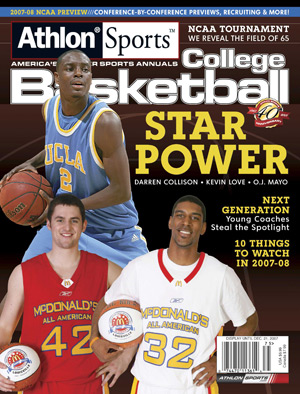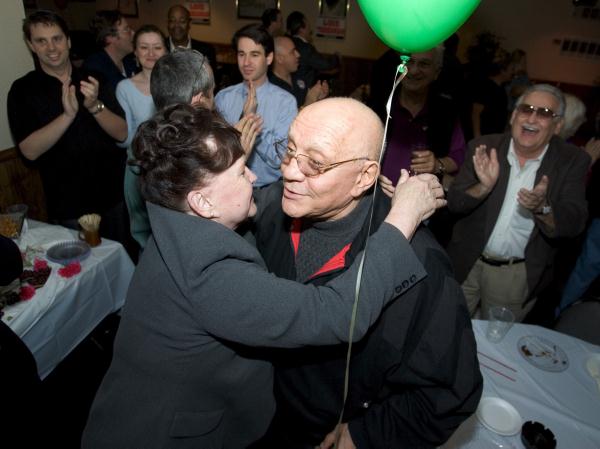2008-09 Season Primers: #13 – WAC
Posted by rtmsf on October 30th, 2008Kevin McCarthy from Parsing The WAC and Sam Wasson from bleedCrimson.net are the RTC correspondents for the WAC.
Predicted Order of Finish:
(Kevin’s Prediction)
- Nevada
- Utah State
- Louisiana Tech
- San Jose State
- New Mexico State
- Boise State
- Hawai’i
- Fresno State
- Idaho
(Sam’s Prediction)
- Nevada
- Utah State
- New Mexico State
- Louisiana Tech
- San Jose State
- Boise State
- Hawai’i
- Fresno State
- Idaho
WYN2K. The most unusual aspect about the Western Athletic Conference (WAC) in the fast-approaching season is that there is no league favorite. Yes, the usual suspects Nevada, Utah State and possibly New Mexico State could very well finish at or around the top but there’s no bet-the-house team that will run roughshod over the other squads. Adding some spice to the recipe, Louisiana Tech and San Jose State are now ready to complicate matters and join the big brothers of the league, making it a five-dom vying for the top spot in 2008-2009. The WAC should be affixed with a ‘high degree of parity’ label but this new season also offers a definite divide: a schism of the five most competitive teams and then the four remaining and re-tooling squads.
Predicted Champion. The winner can be reached via Highway 80…that’s Nevada (NCAA #12) for the geographically destitute.
Others Considered. Utah State, Louisiana Tech, San Jose State and New Mexico State all offer the possibility of taking the league crown.
RPI Booster Games. If any of these games become victories for The Big Five of the WAC or Boise State, Fresno State, Hawaii and Idaho then it’s a boost to the conference power ranking.
Boise State
- @ BYU (10.10.08)
- @ San Diego (10.22.08)
Fresno State
- @ St. Mary’s (11.17.08)
- v. UNLV (12.03.08)
Hawaii
- @ Illinois (12.08.08)
Idaho
- @ Michigan State (11.16.08)
- @ Gonzaga (11.18.08)
- @ Washington State (12.21.08)
Louisiana Tech
- @ UCLA (12.28.08)
New Mexico State
- @ USC (11.18.08)
- @ Kansas (12.03.08)
- @ New Mexico (12.23.08)
- v. New Mexico (12.30.08)
Nevada
- @ San Diego (11.15.08)
- v. UNLV (12.06.08)
- v. North Carolina (12.31.08)
San Jose State
- @ San Diego (11.08.08)
- @ St. Mary’s (11.27-28.08)
Utah State
- @ BYU (12.06.08)
- v. Utah (12.22.08)
The Circular Firing Squad. In 2008-2009, leaving town to play league opponents will not have any WAC teams cheerily singing of yellow brick roads, more a frosty recital wishing for roads less taken.
Multiple NCAA Bids. It won’t happen this season due to multiple poor non-conference schedules and also because of intra-conference battles that will hemorrhage league win-loss records.
Possible NCAA Success. Not likely as Nevada will be a year of experience and another solid frontcourter away from nabbing at least one Big Dance victory.
NIT. After the WAC champion heads off to the NCAAs, complete with visions of making it to Ford Field dancing in their heads, look for four NIT invites to be extended to Utah State, Louisiana Tech, San Jose State and New Mexico State respectively. Utah State has a string of nine straight postseason bids while Louisiana Tech and San Jose State will be game to host or head anywhere after the WAC tournament in order to extend their seasons, as will New Mexico State.
The Widest WAC Shoulders aka The MVP. Luke Babbitt. This Nevada freshman will be THE MAN in the frontcourt for Coach Mark Fox. He needs to be as the Wolf Pack has very little firepower at the one and two positions except for him. So how long will it take Reno-ites to label Babbitt as Hot Hand Luke?
WAC All-Leaguers. Gary Wilkinson – Utah State, Brandon Fields – Nevada, Jonathan Gibson – New Mexico State, Magnum Rolle – Louisiana Tech, Adrian Oliver – San Jose State.
Contenders. Kyle Gibson, Louisiana Tech, Roderick Flemings – Hawaii, Armon Johnson – Nevada, Sylvester Seay – Fresno State, Jahmar Young – New Mexico State, C.J. Webster – San Jose State, Mac Hopson – Idaho
Questions to be answered.
- Can Utah State’s 6′ 9″ Gary Wilkinson dominate this season?
- Who will be the greater contributor for USU, Tai Wesley, Tyler Newbold or will it be equal?
- Will 6′ 10″ Brandon Webster step forward this season or remain a ‘tease’ for Fresno State?
- Can Roderick Flemings average a double-double for Hawaii?
- Will someone step up at the point for Louisiana Tech head coach Kerry Rupp?
- Can oft-injured Richie Phillips and necomers Dario Hunt and Ahyaro Phillips provide enough help upfront for Luke Babbitt at Nevada?
- How long will it take for San Jose State’s Adrian Oliver to discard his rustiness from sitting out?
- Will Johnathan Gibson or Jahmar Young, or both, step up the most for New Mexico State?
- How will the roster turnover at New Mexico State roster affect the team’s chemistry. Five seniors graduated and underclassmen Herb Pope, Jaydee Luster, DeAngelo Williams, Chris Cole, Paris Carter, Johnnie Higgins left the program in the offseason while Wendell McKines left briefly but came back. The Aggies also added Mick Durham as assistant coach to replace Matt Grady.
Did You Know. The 2007-08 season saw four teams tie for the regular season title at 12-4 (Nevada, Utah State, Boise State and New Mexico State).
Final Thoughts. Unlike last season, most of the better talents in the WAC should be returning in 2009-2010 as just Gary Wilkinson among the top players completes his eligibility. This bodes well for multi-Big Dance WAC invites down the road, as the league could be a year away from returning to its perch as one of the premier high mid-major conferences.

















































